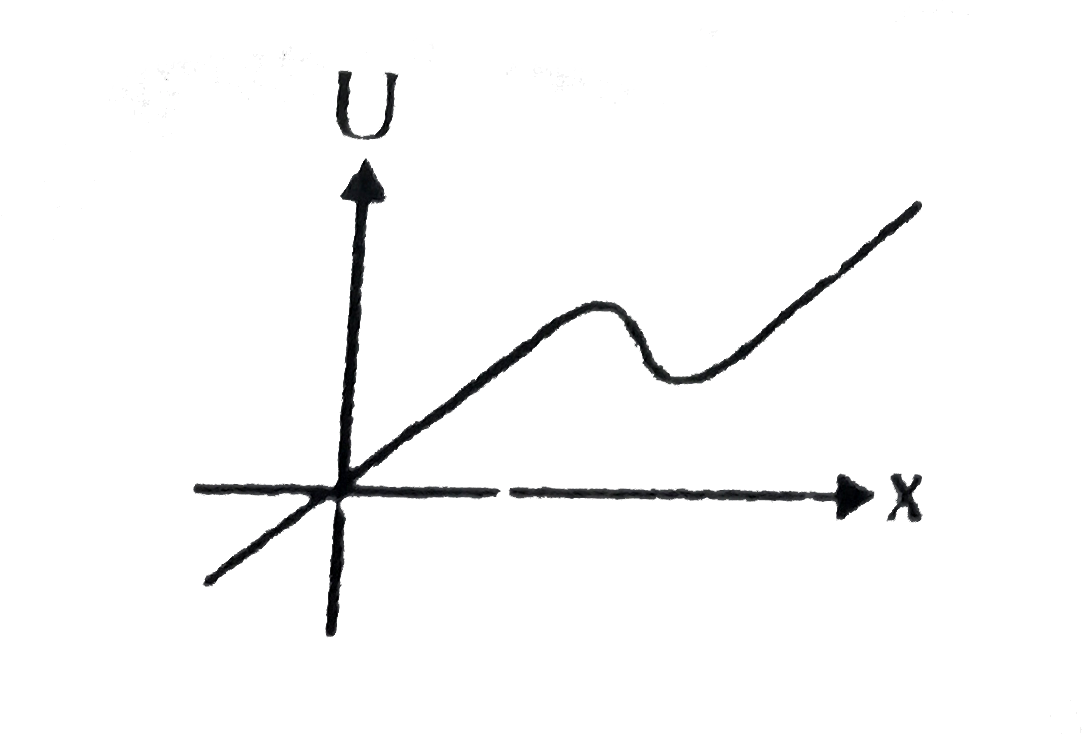A particle of mass 1.5 kg moves along x-axis in a conservative force field. Its potential energy is given by V(x)=2x3−9x2+12x, where all quantities are written in SI units. The plot of this potential energy is given below.
 It is seen that the particle can be in stable equilibrium at a point on x-axis, x_(0). When it is displaced slightly from this equilibrium position, It executes SHM with time period T. What is the range of total mechanical energy of the particle for which its motion can be oscillatory about a point
It is seen that the particle can be in stable equilibrium at a point on x-axis, x_(0). When it is displaced slightly from this equilibrium position, It executes SHM with time period T. What is the range of total mechanical energy of the particle for which its motion can be oscillatory about a point
E<5J
E<8J
E<12J
E<9J
The correct Answer is:A
Vmaxatdvdx=0
6x2−18x+12=0
x2−3x+2=0
x=1,2
d2vdx2=2x−3
=−1atx=1⇒maxiμm
=1atx=2⇒miniμm
Motion can be oscillatory about x=2
E<Emax
Emax=2×13−9×12+12=5j
Topper's Solved these Questions
- MASTER PRACTICE PROBLEMBook:BANSALChapter:MASTER PRACTICE PROBLEMExercise:Reasoning
Explore 75 Videos
- MASTER PRACTICE PROBLEMBook:BANSALChapter:MASTER PRACTICE PROBLEMExercise:Multiple objective
Explore 131 Videos
- MASTER PRACTICE PROBLEMBook:BANSALChapter:MASTER PRACTICE PROBLEMExercise:Additional topic
Explore 70 Videos
- FLUID MECHANICSBook:BANSALChapter:FLUID MECHANICSExercise:PYQS AIEEE
Explore 10 Videos
- SEMICONDUCTORSBook:BANSALChapter:SEMICONDUCTORSExercise:CBSE Question
Explore 32 Videos
Similar Questions
A particle of mass m is free to move along x axis under the influence of a conservative force. The potential energy of the particle is given by U=−axxe−bx [a and b are positive constants]
Find the frequency of small oscillations of the particle about its equilibrium position
View SolutionA partical of mass 2kg is moving on the x−axis with a constant mechanical energy 20J. Its potential energy at any x is U=(16−x2)J where x is in metre. The minimum velocity of particle is :−
View Solution
Knowledge Check
A particle of mass 1.5 kg moves along x-axis in a conservative force field. Its potential energy is given by V(x)=2x3−9x2+12x, where all quantities are written in SI units. The plot of this potential energy is given below.
 It is seen that the particle can be in stable equilibrium at a point on x-axis, x_(0). When it is displaced slightly from this equilibrium position, It executes SHM with time period T. What is the value of x0 ?A2mB3mC1mD1.5 m
It is seen that the particle can be in stable equilibrium at a point on x-axis, x_(0). When it is displaced slightly from this equilibrium position, It executes SHM with time period T. What is the value of x0 ?A2mB3mC1mD1.5 mA particle of mass 1.5 kg moves along x-axis in a conservative force field. Its potential energy is given by V(x)=2x3−9x2+12x, where all quantities are written in SI units. The plot of this potential energy is given below.
 It is seen that the particle can be in stable equilibrium at a point on x-axis, x_(0). When it is displaced slightly from this equilibrium position, It executes SHM with time period T. What is the time period of SHM mentioned in the paragraph?AπsecB2πsecCπ2secDπ4sec
It is seen that the particle can be in stable equilibrium at a point on x-axis, x_(0). When it is displaced slightly from this equilibrium position, It executes SHM with time period T. What is the time period of SHM mentioned in the paragraph?AπsecB2πsecCπ2secDπ4secA particle of mass m is executing osciallations about the origin on the x-axis with amplitude A. its potential energy is given as U(x)=αx4, where α is a positive constant. The x-coordinate of mass where potential energy is one-third the kinetic energy of particle is
A±A2B±A√2C±A3D±A√3
A particle of mass m is located in a one dimensional potential field where potential energy of the particle has the form U(x)=ax2−bx where a and b are positive constants. The position of equilibrium is:
View SolutionThe potential energy of a particle (Ux) executing SHM is given by
View SolutionA particle of mass 2 kg moving along x-axis has potential energy given by, U=16x2−32x ( in joule), where x is in metre. Its speed when passing through x=1is2ms−1
View SolutionA particle of mass m is executing oscillations about origin on the x axis amplitude A its potential energy is given asU(x)=βx4 where β is constant x cooridirate of the particle where the potential energy is one third of the kinetic energy is
View SolutionPotential energy of a particle is related to x coordinate by equation x2−2x . Particle will be in stable equilibrium at :
View Solution

